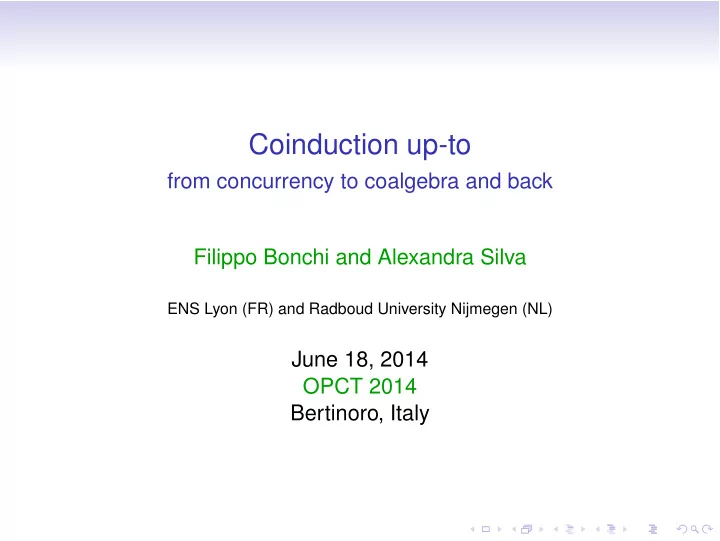

Coinduction up-to from concurrency to coalgebra and back Filippo Bonchi and Alexandra Silva ENS Lyon (FR) and Radboud University Nijmegen (NL) June 18, 2014 OPCT 2014 Bertinoro, Italy
Context • Automata are basic structures in Computer Science. • Language equivalence: well-studied, several algorithms. • Renewed attention (POPL ’11, ’13, ’14).
Context • Concurrency: a spectrum of equivalences. • Checking usually done by reducing to bisimilarity.
An alternative road • Many efficient algorithms for equivalence of automata. • Applications in concurrency?
From automata to concurrency Various spectrum equivalences = Language equivalence of a transformed system = Automaton with outputs and structured state space (Moore automata). Bonsangue, Bonchi, Caltais, Rutten, S. MFPS 12
From automata to concurrency • Generalization of existing algorithms to Moore automata. • Brzozowski’s and Hopcroft/Karp algorithms for van Glabbeek’s spectrum. • Cleaveland and Hennessy’s acceptance graphs for must/may testing = Moore automata. • Brzozowski’s and Hopcroft/Karp algorithms algorithm for must/may testing. Bonchi, Caltais, Pous, Silva. APLAS 2013
From automata to concurrency • Generalization of existing algorithms to Moore automata. • Brzozowski’s and Hopcroft/Karp algorithms for van Glabbeek’s spectrum. • Cleaveland and Hennessy’s acceptance graphs for must/may testing = Moore automata. • Brzozowski’s and Hopcroft/Karp algorithms algorithm for must/may testing. Bonchi, Caltais, Pous, Silva. APLAS 2013
The approach
Roadmap 1. Automata algorithms applied to concurrency. 2. For the rest of the talk: up-to techniques applied to automata. Compositionality Coinduction [ [X + Y] ] = [ [X] ] + [ [Y] ] Proof principle for infinite structures
Roadmap 1. Automata algorithms applied to concurrency. 2. For the rest of the talk: up-to techniques applied to automata. Compositionality Coinduction [ [X + Y] ] = [ [X] ] + [ [Y] ] Proof principle for infinite structures
The rest of the talk ● Deterministic Automata – Naive algorithm (for language equivalence) – Hopcroft & Karp's algorithm ● Non-Deterministic Automata – Powerset Construction – On the fly algorithm – H&K-up-to-congruence algorithm ● Discussion and Future Work
The rest of the talk ● Deterministic Automata – Naive algorithm (for language equivalence) – Hopcroft & Karp's algorithm ● Non-Deterministic Automata – Powerset Construction – On the fly algorithm – H&K-up-to-congruence algorithm ● Discussion and Future Work
Deterministic Automata (S,o,t) set of states S output function o: S-->2 A transition function t: S-->S Accepted Language Language Equivalence
Language Equivalence via Bisimulations Given an automaton <o,t>:S-->2xS A , B:Rel_S-->Rel_S is defined for all R ⊆ S × S as B (R)= {(x,y) | o(x)=o(y) & ∀ a ∈ A, (t(x)(a),t(y)(a)) ∈ R } νΒ is language equivalence νΒ Def: A bisimulation is a relation R such that R ⊆ B (R) Coinduction Proof Principle: L(x)=L(y) iff (x,y) ∈ R , for some bisimulation R
R ⊆ B (R ∪ todo) After (3), R ⊆ B (R)
Hopcroft and Karp's Algorithm (1971)
Hopcroft and Karp's Algorithm (1971)
R ⊆ B ( E (R) ∪ todo) E At most n times! The complexity is n log(n) After (3), R ⊆ B ( E (R)) i.e, R is a bisimulation up-to equivalence
Mistakes in Milner's book Weak Bisimulation up-to Equivalence Weak Bisimulation up-to Weak Bisimilarity
Plan of the Talk ● Deterministic Automata – Naive algorithm (for language equivalence) – Hopcroft & Karp's algorithm ● Non-Deterministic Automata – Powerset Construction – On the fly algorithm – H&K-up-to-congruence algorithm ● Discussion and Future Work
Semi-Lattices a set Associative-Commutative-Idempotent the identity element Examples
Semi-Lattices a set Associative-Commutative-Idempotent the identity element Homomorphisms
Non-Deterministic Automata (S,o, δ ) S set of states o: S-->2 output function A transition relation δ : S-->P(S)
Determinization
Accepted Language # , δ # ) (P(S),o (S,o, δ ) A bisimulation is a relation R ⊆ P(S) × P(S) such that R ⊆ B (R) where B:Rel_P(S)-->Rel_P(S) is defined as For all R ⊆ P(S) × P(S), B (R)= {(X,Y) | o # (X)=o # (Y) & a ∀ ∈ δ # (X)(a), δ # (Y)(a)) ∈ A, ( R } Coinduction Proof Principle: iff (X,Y) ∈ , for some bisimulation R R
E
Our Idea...
R ⊆ B ( C (R) ∪ todo) C After (3), R ⊆ B ( C (R)) namely, R is a bisimulation up-to congruence
Conclusions ● Implementation is available online (Googling HKC automata) and more and more used (already 24 citations, see e.g., www.languageinclusion.org) ● Interactive Applet & COQ proof scripts ● A follow-up will appear in LICS 2014 ● Weighted Automata, Nominal Automata, Process Calculi ● Different sort of Coinductive Predicates like Termination, Similarity, Weak Bisimilarity
Antichain Approach AC M. D. Wulf, L. Doyen, T. A. Henzinger, and J.-F. Raskin. Antichains: A new algorithm for checking universality of finite automata. In Proc. CAV 2006. AC' P. A. Abdulla, Y.-F. Chen, L. Holik, R. Mayr, and T. Vojnar. When simulation meets antichains. In Proc. TACAS 2010. Following AC', we developed another algorithm called HKC'
Experimental Assessment
Recommend
More recommend